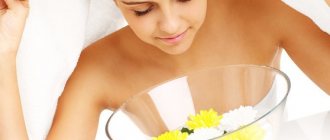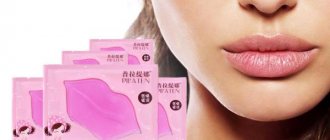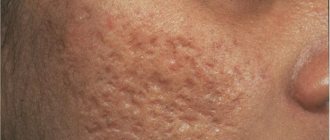Do you live in an ecological paradise far from civilization, wash your face with spring water, eat only healthy gifts of nature, and always take care of the vigor of your body and joy of spirit? Oh, if only!
Our skin is exposed to many harmful factors every day, and by the age of 25-30, aging mechanisms are launched in it. It dries out, loses its elasticity, becomes wrinkled, and turns gray.
We begin to help our face as early as possible in order to delay and minimize the loss of elasticity.
If the skin is already becoming flabby, we tighten it in three weeks without injections and for a long time.
Why does skin lose elasticity?
Skin elasticity is its ability to resist mechanical stress. In medicine, the term “turgor” is used to evaluate this property. It is determined by the tension of the skin-fat fold.
Pinch the skin on your cheekbones with your thumb and forefinger, pull it up and release. If the fold straightens out in an instant, it means that the turgor is preserved. If with slowdown, turgor is reduced.
What internal mechanisms affect skin elasticity:
- A straight back and a healthy neck.
Incorrect posture and spasmodic platysma (“the muscle of youth” that lines the neck) accelerate facial aging. The skin becomes flabby, sagging on the lower edges of the cheeks, on the upper eyelids, a double chin appears, and the oval of the face floats down. - The quantity and quality of elastin and collagen in the skin.
When “building” proteins are produced less actively and become damaged, the skin withers. - Water-salt balance.
When the body is dehydrated, the skin loses its elasticity. - Condition of subcutaneous fat.
Reducing the volume of fat packets provokes skin ptosis. - Activity of blood flow and lymphatic drainage.
When blood flow slows, cells do not receive enough nutrients and oxygen. And when lymph flow is disrupted, excess fluid accumulates in the tissues of the face, it swells, and the skin becomes loose.
Skin turgor decreases with age. The processes begin at the age of 25, and gradually the skin becomes flabby, wrinkled, thin, and dry.
But age is not the only reason why skin loses its elasticity. There are others too.
Ways to tighten the oval face
- Surgery is the most effective, but at the same time expensive and complex method, which is accompanied by a long recovery period.
- Hardware correction is a more gentle, non-invasive method, but less effective.
- Facial gymnastics is useless for an older person and is suitable as a preventive measure at the turn of 30-35 years.
- Thread lifting and contour injection plastic surgery are modern, gentle techniques that are considered the best choice when there are contraindications to surgery or you simply want to avoid the unpleasant consequences of surgery.
Traditionally, contour plastic methods are used to correct the oval of the face . A number of experts recommend plastic surgery, but these interventions are aimed exclusively at lifting; it is impossible to replenish the volume lost with age using surgery .
TOP 12 reasons for loss of skin elasticity at any age
- Incorrect posture.
Do you slouch and pull your head forward when sitting at the computer? Do you read while lying down? Do you sleep curled up on one side? All this steals youth from your face. - Physical and emotional fatigue.
Due to stress and heavy workload, the face can become haggard. Pale color with an earthy tint, sunken eyes, folded skin - a familiar portrait? - Eating disorder.
Harmful, unbalanced, poor or excessive nutrition - all this harms the skin. The body must receive a sufficient amount of nutrients, vitamins, minerals and not an ounce of “food waste”. - Weight fluctuations.
Due to the accumulation of kilograms, the skin stretches, and as a result of sudden weight loss, it sags. - Cigarettes and alcohol.
They dry out the skin and deprive it of its protective properties. Have you seen photos of twins, one of whom smokes, the other does not? Look for them on the Internet, they are more eloquent than any words. The smoker's facial skin will be flabby, saggy, wrinkled, gray-sallow, while her twin's will be elastic and fresh. - Physical inactivity.
A sedentary lifestyle slows down blood circulation, metabolism, nutrition and cell regeneration. - Hormonal imbalances.
Women's skin reacts especially sensitively to the level of its “beauty hormone” - estrogen. If there is not enough of it, the skin fades. Typically, estrogen production decreases during menopause, but hormonal imbalances also occur at a young age. - Lack of fluid.
The clean water you drink quickly reaches your skin and gives it the moisture it needs. If you drink little, your skin becomes dry and flabby. - Aggressive external factors: sun, frost, wind, dust, dry air.
Excessive exposure to ultraviolet rays is especially harmful. They destroy elastin and collagen fibers - the “building” protein on which the youth of the skin depends. - Most cosmetic procedures.
Any external invasion - plastic surgery, threads, Botox injections, fillers - weanes the skin (as well as other tissues and organs) from working correctly. The external effect of the procedure only lasts for a while, but negative processes occur inside that lead to aging. - Incorrect use of cosmetics.
You need to monitor the composition of cosmetic products, do not overuse decorative cosmetics, and follow the rules of the daily “cleansing-moisturizing-nutrition” ritual. - Pathological reasons.
This includes disorders of the nervous, endocrine, cardiovascular systems, gastrointestinal tract, etc.
Prevention of loss of facial skin elasticity
Do you want to prolong the youth of your face?
- The first piece of advice is to watch your posture.
How do you sit at the computer: do you slouch, pull your head forward, lean your elbows to one side?Do you like to read while lying down?
Do you sleep on a soft mattress and high pillows, on one side or face down?
How much time do you spend on gadgets, hunched over and pressing your chin into your chest?
All this is harmful to your back, shoulders, neck and, as a result, to the elasticity of your facial skin.
- Do not overuse sunbathing and solariums.
Limit your time in direct sunlight. Use creams with UV filters, sunglasses, and wear hats with large brims. - Move a lot
An adult needs 30-60 minutes of moderate-intensity activity every day. Medium is one in which the heart rate increases, but can be maintained for more than 10 minutes. The most accessible option for such a load is walking (at least 7,000 steps per day).We also run, jump, swim, ride a bike, and play sports games.
All this is necessary to ensure that the muscles are in healthy tone, blood and lymph flow through the vessels without delay, and no excess fat or swelling puts pressure on the musculoskeletal system and does not pull the facial tissues down.
- Follow food and drinking regimes
Eliminate “food waste” from your diet, don’t overeat, don’t starve, ensure that you get all the necessary nutrients, fiber, vitamins, and microelements from your food.For youthful and elastic skin, it is useful to consume foods containing silicon, iron, selenium, zinc and the entire list of vitamins from A to P.
Drink at least 2 liters of clean water per day - this will create the basis for your skin and muscles to be elastic and hydrated.
By eating right, you will also eliminate weight fluctuations that are harmful to skin elasticity.
- Give up bad habits
Do not smoke or abuse alcohol - do not allow toxic substances into your body that lead to dehydration, thinning of the skin, loss of turgor and elasticity.
And some tips for caring for your skin.
What useful habits should you develop to keep your skin elastic for as long as possible:
- Take care of your face with cosmetics twice a day.
Morning and evening, cleanse, moisturize and nourish.To cleanse, use mild products that will not dry out your skin. The ideal option is to wipe your face with a cotton pad soaked in hydrosol (plant distillate).
To moisturize and nourish, choose natural products: oils, balms, squalane. They contain many useful, anti-aging components.
Choose hydrolates, oils, squalanes and balms from the Beauty365 brand at www.beauty365.ru. Find a detailed guide to the means below.
- Do gymnastics and self-massage of the face
Exercises and self-massage can be done at any age: both teenagers and women after menopause. If you are over 30, they should become a mandatory part of your beauty ritual.This is the basis for natural rejuvenation, a direct effect on the skin, muscles, blood vessels, lymph without injections or scalpels. The causes of skin aging are eliminated from the inside.
Make it a rule to knead your face along massage lines for 10-15 minutes a day, reduce swelling and perform simple exercises. At a young age, it is enough to do this 2 times a week.
If the problem of loss of skin elasticity has already become apparent, classes should be daily, the course should be at least three weeks.
- Perform self-massage with a dry brush (drybrushing) and vacuum cups
The jar and brush improve blood circulation, remove lymph, and tighten the skin. The brush also removes dead scales, which promotes skin renewal.It is better to alternate jars and brush. It is enough to perform the procedure 1-2 times a week.
Choose the Beauty365 Dry Facial Brush, which is made with boar bristles, and Beauty365 glass jars. They can be found at www.beauty365.ru.
How to perform the procedures?
Vacuum self-massage with cups.
Apply squalane or oil to your face for easy sliding of the cans (choose suitable Beauty365 products at www.beauty365.ru) and repeat the technique from the video:
Dry massage with a brush.
Rub clean and dry facial skin along the massage lines (indicated on the packaging of the Beauty365 dry facial brush). After the procedure, nourish the skin with cream, oil or squalane.
When there is a need to improve skin elasticity
When should you start taking care of keeping your skin elastic? If you read the top 12 reasons for loss of elasticity, then you can answer this question yourself. This should always be done.
The girl was recently born, and we are already protecting the baby from the sun, monitoring her nutrition, fluid intake, sleep, posture, and health. We, of course, do not think about any elasticity of the skin, but we are already laying the foundation.
In adolescence, a girl begins to take care of her skin herself - she moves to a conscious stage, but for now it is about maintaining the beauty that nature has given her.
And the new milestone is 25-30 years. At this age, aging mechanisms begin. You need to carefully monitor the condition of your skin on all counts, strengthen your care with anti-aging products, include exercises and self-massage of the face. The sooner you start doing all this, the longer you will maintain your youth.
And it's never too late to start taking care of your face. Natural rejuvenation techniques can make your skin firmer at any age.
What is skin elasticity
The elasticity of the skin is its ability to maintain its structure when stretched. Elastin is responsible for this property - a type of protein fiber that is found in the dermis (the supporting layer of the skin).
Compared to another protein - collagen - there is several times less elastin in the skin, but it is no less important.
In general, the properties of the dermis, which are provided by elastin and collagen, are closely related. If elastin gives elasticity, then collagen gives elasticity, that is, the ability to return to its original shape after stretching or squeezing.
These two characteristics - elasticity and resilience - are often used separated by commas or generally as synonyms. They are difficult to separate from each other. Therefore, we will talk about them together.
So, collagen
- This is the main building material of the dermis. Its “spirals” are like springs for a mattress for our skin. They allow it to easily recover from compression (or stretching).
Elastin
works a little differently. Its fibers are arranged diagonally at different angles. They seem to hold the dermis together, preventing the separation of its components.
Collagen and elastin fibers intertwine with each other, providing the skin with a single “framework of youth”. Both proteins are produced by the same cells - fibroblasts.
What determines the youthful, healthy state of elastin and collagen?
- Active work of fibroblasts.
- Quality of fibers: they must be strong, intact, ordered.
What does the face look like when the skin loses firmness and elasticity? The integument becomes flabby, sagging on the cheeks, upper eyelids and under the lower jaw, the oval of the face floats down and “squares up”, jowls and a double chin appear.
How to make facial skin more elastic at home
Nothing will help your skin become elastic like you.
You can, of course, go to a cosmetologist for safe procedures that are not associated with damage to the skin. For example, for some peeling or massage. But it’s not painful to rush into the salon, and care must be constant.
It is much easier and more convenient to independently master anti-aging techniques that will help restore the elasticity of your skin.
Follow three basic rules:
- Healthy eating.
Eat healthy foods, avoid “food waste,” and watch your caloric intake. - Competent cosmetic care.
Choose the right anti-aging cosmetics or make it yourself from natural ingredients. - Self-massage and exercises.
Spend 10-15 minutes a day on your face every day. Your hands are the best replacement for injections and scalpels.
What foods help improve skin elasticity?
For youthful and elastic skin, it is useful to consume products containing:
- silicon (bran, oats, barley, black bread, potatoes, peppers, celery, onions, radishes, tomatoes, parsley),
- iron (buckwheat, egg yolk, oatmeal, liver, rabbit, chicken, veal, lamb),
- selenium (whole grain wheat bread, brown rice, coconuts, Brazil nuts, sardines, tuna, liver, garlic, eggs),
- zinc (seafood, fish, beef liver and meat, mushrooms, nuts, wheat bran).
Make sure you have plenty of vitamins in your diet. There is no point in talking about the benefits of each of them separately, because to rejuvenate the skin and increase its elasticity, they all are needed: A, B, C, D, E, F, K, N, P, PP.
First of all, vitamins A (retinol), B5 (panthenol), B7 (biotin), B9 (folic acid), C (ascorbic acid), E (tocopherol), F (linoleic acid) are useful for youthful skin.
Top cosmetics for skin elasticity and tone
What do we put on our face?
Products with a large amount of vitamins and fatty acids that are beneficial for skin elasticity. They are found in natural cosmetics: hydrosols, oils, squalane, balms.
You should choose the right products, starting from the first stage of skin care - cleansing. Beauty365 hydrosols are perfect for this.
– natural distillates that are charged with the benefits of plants. Go to www.beauty365.ru and choose lavender, mint or sage hydrosol depending on your skin type. Wipe your face with it instead of washing your face, remove makeup, and moisturize your skin throughout the day.
For more intense hydration and nutrition, use natural products that increase skin elasticity (all of them can be found in the online store www.beauty365.ru):
- Beauty365 Squalane
is a lightweight oil option. Absorbs quickly and leaves no residue. Great for moisturizing and nourishing the skin before makeup, as well as for self-massage of the face with vacuum cups. - Coconut oil Beauty365
– a hit in the care of aging skin, a life-giving cocktail for rejuvenation. It is especially recommended for those who have dry and sensitive skin prone to irritation and inflammation. - Beauty365 camellia sasanqua oil
is a unique product containing vitamins A, B, E and fatty acids. It copes well with its anti-aging tasks: moisturizing, regeneration, antioxidant effect. In addition, it helps to whiten age spots - a common defect of aging skin. - Hemp balm Verbena Beauty365
combines the benefits of six plants at once: hemp, coconut, pistachio, shea, calendula, carrots. A powerful charge for skin elasticity. Rejuvenates, nourishes, fights free radicals, promotes moisture retention and cell renewal.
Is it worth using salon treatments?
Do you want to tighten your facial skin and are thinking about salon treatments?
Cosmetologists and plastic surgeons have two main weapons against any age-related defect: pricking and cutting. Also with the firmness and elasticity of the skin.
What can they offer you in a cosmetology salon?
- Surgical facelift.
They cut off your excess skin, and the remainder is stretched and stitched up. - Thread lifting.
Incisions are made in the skin and threads are inserted through them and pulled across the face. The threads can be absorbable or permanent. But in any case, the tissues around them degenerate from healthy to fibrotic. Thus, due to scarring and swelling, the effect of tightened skin is created for some time.- Botox.
Paralyzes the facial muscles. The muscles stop contracting and lengthen. And then the skin straightens out. - Fillers.
The skin is pumped up with fillers. The gel literally pushes and stretches the dermis, acting as an aggressor and disrupting self-regulation mechanisms. - Mesotherapy, biorevitalization, plasma lifting.
All three methods rely on multiple skin punctures. Several hundred injections are given to the face in one session, and the course consists of many procedures. Such an attack with needles causes total tissue injury. The result is widespread scarring and swelling. They create the effect of tightened skin.Mesotherapy, biorevitalization and plasma lifting differ from each other only in the type of drug administered (and it does not play a special role). Mesotherapy uses a cocktail of different synthesized substances, biorevitalization uses hyaluronic acid, and plasma lifting uses the patient’s own plasma.
- Hardware methods: laser, radio waves, ultrasound, light, cold, etc.
As a rule, their action is based on tissue damage. Using laser, radio waves, ultrasound, and light, the tissues are burned out, and the burn site is “patched” with new “building material.” Cold “freezes” and breaks down fat. None of these methods solve the problem of skin loss of elasticity.
All these methods are harmful to health, destructive to the skin and accelerate its aging. They do not rejuvenate the skin or make it firmer and more elastic. It's the other way around. They create conditions for accelerated aging of the skin, its thinning, loss of turgor and elasticity. Because of them, self-regulation suffers, and all processes are disrupted: from the delivery of nutrition and moisture to the cells to the renewal of the “building material” of the dermis.
Complications may also occur, including tissue and vascular necrosis, damage to the facial nerve, skin loss, blood clot formation, etc.
We are categorically against cutting, “stitching” the skin, “stuffing” it with fillers, pricking it to the point of scarring, paralyzing the facial muscles, etc.
What to do then?
Change your lifestyle and use natural rejuvenation techniques. But first things first.
How to use skin firming oils
- Oils can be used independently or added to cream.
- Before applying the oil, it is recommended to warm up, disperse the blood and lymph, and prepare the skin so that it can better absorb all the vitamins and fatty acids it needs.
The easiest way is to take a hot bath.An amazing effect can be achieved if you perform a dry massage with a brush before applying the oil. It will cleanse the stratum corneum of dead scales, trigger epidermis renewal mechanisms, and increase the movement of blood and lymph.
We recommend using the Beauty365 dry facial massage brush, which is made of boar bristles. You can find it in the online store www.beauty365.ru.
- Apply oils to a clean face morning and evening.
For the morning, squalane is better, as it is quickly absorbed and leaves no residue. Before going to bed, you can treat yourself to a thicker oil. The most effective way to use oil is in combination with vacuum massage with jars (read about it below).
What masks are there that increase skin elasticity?
In combination with other measures (self-massage, exercise, proper nutrition), homemade face masks will help increase skin elasticity. They can be prepared from simple products that can be found in every kitchen:
- gelatin,
- rice,
- oatmeal,
- Rye bread,
- cucumbers,
- dill,
- potato,
- lemon,
- eggs.
Experience their benefits for yourself.
Recipes for masks for skin elasticity:
- Gelatin mask
Half a tbsp. l. Dissolve gelatin in 3 tbsp. l. hot water and cool. Add 3-5 drops of lemon juice and 1 yolk. - Bread mask
1 piece of rye bread + a third of a glass of warm milk + 1 tsp. honey - Lemon mask
5 k lemon juice + 1 tbsp. l. olive oil + 1 yolk. - Oatmeal mask
2 tbsp. l. oatmeal (pour hot water or milk) + 1 tsp. olive oil + 1 tbsp. l. sour cream. - Potato mask
1 jacket potato + 1 tsp. sour cream + 1 tsp. vegetable oil. Apply to face while warm and cover with a towel.
Keep the masks on your face for 20 minutes. We do it 2 times a week.
Water procedures, massage
It is worth doing a facial massage for skin elasticity. It will help fight cellulite, reduce fat accumulation, accelerate cell regeneration, and stimulate blood circulation. And in general, massage has a positive effect on the body. When it comes to the chin and face, you need to massage for 10 minutes, but do it daily. Initially, they stroke the chin, forehead, cheeks, then pat, lightly knead and rub.
Warm baths and contrast showers can also have a positive effect on the condition of your facial skin. Hot water helps stimulate blood circulation, steam the skin, dilate blood vessels, and cold water trains them.











